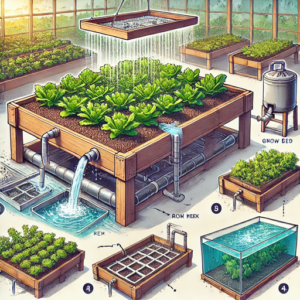
How to Build an Aquaponics Grow Bed. Hey there, fellow gardening enthusiast! Are you ready to dive into the world of aquaponics? I’m thrilled to share my passion for this innovative gardening method with you. Today, we’re going to explore how to build an aquaponics grow bed – a key component in any aquaponics system. Trust me, once you’ve built your own grow bed, you’ll wonder why you didn’t start sooner!
What is an Aquaponics Grow Bed?
Before we roll up our sleeves, let’s quickly cover what an aquaponics grow bed actually is. Simply put, it’s the heart of your aquaponics system – where your plants will thrive. It’s a container filled with growing media that receives nutrient-rich water from your fish tank. The plants absorb these nutrients, cleaning the water in the process, which is then returned to the fish. It’s a beautiful, symbiotic relationship!
Benefits of Building Your Own Grow Bed
Now, you might be wondering, “Why should I build my own grow bed?” Well, let me tell you, there are plenty of reasons:
- Cost-effective: DIY is almost always cheaper than buying pre-made.
- Customizable: You can tailor the size and shape to fit your space perfectly.
- Quality control: You know exactly what materials are used and how they are assembled.
- Satisfaction: There’s nothing quite like the pride of creating something with your own hands!
Materials Needed
Alright, let’s get down to business. Here’s what you’ll need to build your aquaponics grow bed:
Container Options
You’ve got several choices here:
-
- IBC totes (my personal favorite)
- Food-grade plastic containers
- Wooden boxes lined with pond liner
- Repurposed bathtubs or large sinks
Plumbing Components
-
- PVC pipes and fittings
- Bulkhead fittings
- Bell siphon (we’ll talk more about this later)
Growing Media
-
- Expanded clay pebbles
- Lava rock
- River stones
Step-by-Step Guide
Choosing the Right Location
First things first – location, location, location! Your grow bed needs:
-
- Plenty of sunlight (at least 6 hours a day)
- A sturdy, level surface
- Proximity to your fish tank
Preparing the Container
-
- Clean your container thoroughly.
- If using a wooden box, line it with a pond liner.
- Drill holes for plumbing (this can be a bit nerve-wracking, but take a deep breath – you’ve got this!)
Installing the Plumbing
This is where things get exciting! We’re going to set up a flood and drain system:
-
- Install a bulkhead fitting at the bottom of your grow bed.
- Attach your bell siphon (this clever device will automatically drain your grow bed when it’s full).
- Connect the intake pipe from your fish tank pump.
Adding the Growing Media
Now for the fun part:
-
- Rinse your chosen media thoroughly.
- Fill your grow bed, leaving about an inch at the top.
- Level it out – we want our plants to have an even playing field!
Connecting to the Fish Tank
-
- Almost there! Connect your grow bed to your fish tank:
- Ensure your pump is powerful enough to cycle water effectively.
- Test your system – watch that water flow!
Maintaining Your Aquaponics Grow Bed
Congratulations! You’ve built your grow bed. But our journey doesn’t end here. Let’s talk maintenance:
Regular Cleaning
Every few months, give your grow bed some TLC:
-
- Remove and rinse your growing media.
- Check for any clogged pipes or fittings.
Monitoring Water Quality
Keep a close eye on:
-
- pH levels (aim for 6.8-7.0)
- Ammonia and nitrate levels
- Water temperature
Plant Care
Just like in traditional gardening, your plants need attention:
-
- Prune regularly
- Watch for pests
- Harvest when ready (and enjoy the fruits of your labor!
Troubleshooting Common Issues
Even the best-built systems can have hiccups. Here are some common problems and solutions:
- Clogged bell siphon: Clean it out and ensure it’s properly sized.
- Uneven water distribution: Level your grow bed and adjust the water flow.
- Algae growth: Reduce sunlight exposure to the water.
Expanding Your System
Once you’ve mastered one grow bed, why stop there? Consider adding:
- Multiple grow beds for crop rotation.
- Different types of grow beds (deep water culture, vertical systems)
- A wider variety of plants and fish
Conclusion
Building your own aquaponics grow bed is a rewarding experience that puts you in control of your food production. It’s sustainable, efficient, and, honestly, pretty darn cool. Remember, every master gardener started as a beginner, so don’t be afraid to get your hands dirty and learn as you go. Happy building, and here’s to bountiful harvests in your future!
FAQs
- How big should my grow bed be?
A good rule of thumb is to have a grow bed that’s about 1/3 the volume of your fish tank. - Can I use any type of fish in my aquaponics system?
While many fish work well, tilapia, goldfish, and trout are popular choices for beginners. - How often should I add water to my system?
You’ll need to top up periodically due to evaporation and plant uptake. Monitor your water levels daily. - Can I grow any type of plant in my aquaponics grow bed?
Most vegetables and herbs do well, but avoid plants that require acidic soil, like blueberries. - Is it necessary to use a bell siphon?
While not absolutely necessary, a bell siphon automates the flood and drain cycle, making your system more efficient and reducing the risk of overflow.
